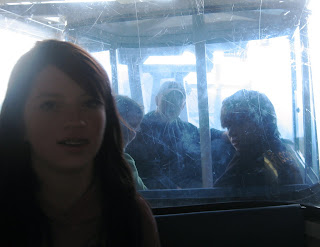 Then it was up on what is reportedly the steepest tramway in the world to the top of Mt. Howard. The tramway ascends 3,700 feet to an altitude of 8,150, the summit of Mt. Howard which looks down on Wallowa Lake and provides scenic views of the Eagle Cap Wilderness to the south and into Idaho to the east. What we liked best was feeding the pocket gophers and chipmunks with healthy food that you can buy at the summit.
Then it was up on what is reportedly the steepest tramway in the world to the top of Mt. Howard. The tramway ascends 3,700 feet to an altitude of 8,150, the summit of Mt. Howard which looks down on Wallowa Lake and provides scenic views of the Eagle Cap Wilderness to the south and into Idaho to the east. What we liked best was feeding the pocket gophers and chipmunks with healthy food that you can buy at the summit.
After coming down from Mt. Howard, Beth and Daniel went swimming in the lake while the rest of us relaxed. We had planned for dinner to go into Joseph to a pizza place that advertised wireless internet. When we got there though, we couldn't find a table. We drove into Enterprise but did not see any eating places that appealed to us there either, so we gave up and ate a a perfectly good place across from our motel at Wallowa Lake featuring homemade potato chips and great homemade desserts.
We woke up early on Tuesday to make an 8 a.m. reservation for breakfast at the Wallowa Lake Lodge, built in 1923 and lovingly restored in recent years. Most of us ordered their specialty, Oregon hazelnut pancakes with marionberry butter. They should have warned us how big they were! They filled a whole plate and were about 3/4 inch thick. Daniel, the big eater, ordered two. Luckily Ann, Jane and I only ordered one. It proved to be a challenge just to finish one.
Then we were off -- home to Salem. After about a hour on scenic back roads to La Grande, it's the I-84 interstate all the way to Portland and I-5 to Salem. Not very interesting. We broke up the drive with lunch at an old favorite -- Charburger in Cascade Locks, the burger place with the million dollar view of the Columbia River. The kids got their last pies of the trip and ate them first while the burgers were cooking.
We got home in good time, about 4 pm and proceeded to do a ton of laundry.
Did we meet our objectives for the trip? Well, out the 26 roadside attractions we listed as possible destinations from roadsideamerica.com, it turns out we only made it to 14. This is mostly because we changed our route at the end and did not spend any time in Washington state. It was worth it to experience Hwy 12 across the middle of Idaho and to be able to spend two days at Wallowa Lake. I'd say we saw the best roadside attractions: the Shoshone Ice Caves, the Sunshine Health Mine, Butte, and the Evel Knievel jump site. We didn't make it to the giant cement potato in Driggs, but we caught the one at the Idaho Potato Expo in Blackfoot. Yellowstone met everyone's expectations. Even with mobs of tourists, it is an amazing one-of-a-kind place.
Will this really be the last road trip for all the Scheppkes? Could be. If that ends up being the case, none of us can say that we didn't have a good one.

















